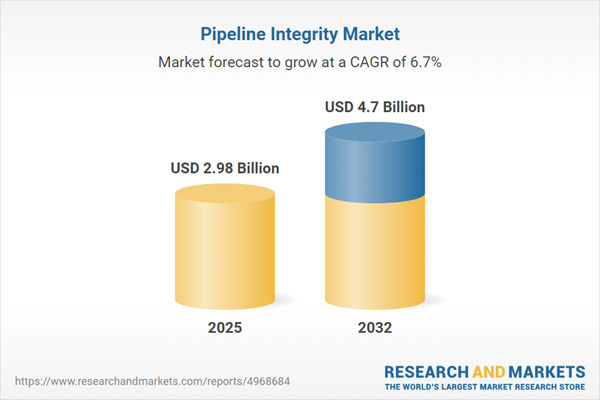Speak directly to the analyst to clarify any post sales queries you may have.
The pipeline integrity market is rapidly evolving as energy operators worldwide focus on meeting regulatory standards, reducing operational downtime, and advancing environmental sustainability. This market overview addresses how organizations are leveraging innovation to manage complex challenges across safety, efficiency, and compliance.
Market Snapshot: Pipeline Integrity Market Growth and Trends
The pipeline integrity market is expected to grow steadily, with projected revenue increasing from USD 2.79 billion in 2024 to USD 2.98 billion in 2025. Sustained growth at a 6.70% CAGR points toward a market size forecast of USD 4.70 billion by 2032. Organizations are prioritizing resilient infrastructure and advanced inspection practices to support increased global energy demand while maintaining safety and environmental safeguards.
Scope & Segmentation of the Pipeline Integrity Market
This report provides comprehensive analysis into pipeline integrity, focusing on several critical segments:
- Technique: Coverage includes eddy current testing (conventional, pulsed), magnetic flux leakage (conventional, high resolution), radiographic testing (gamma ray, X ray), ultrasonic testing (conventional UT, phased array UT), and visual inspection (direct, remote).
- Service: Explores inspection (comprehensive, routine), maintenance (predictive, preventive), monitoring, repair, and testing activities.
- Component: Analysis spans fittings, distribution pipelines, transmission pipelines, pumps, tanks, and valves (ball, gate).
- Material: Encompasses carbon steel, composite, plastic polymer, and stainless steel solutions, addressing both traditional and emerging material demands.
- Platform: Includes aerial drones, inline tools (pig, smart pig), manual tools, and robotic systems, reflecting the adoption of both conventional and automated inspection technologies.
- End User: Reviews sector adoption across chemical plants, oil & gas companies (international and national), pipeline operators (national, private), refineries, and utilities (power, water).
- Regional Coverage: Presents insights into markets across the Americas (North America and Latin America), Europe, Middle East & Africa (including detailed country focus), and Asia-Pacific, capturing diverse market maturity and regulatory conditions.
Key Takeaways for Senior Decision-Makers
- Integrated data analytics and nondestructive evaluation methods are driving earlier detection of pipeline anomalies, supporting reduced operational risks and longer asset lifespan.
- Rapid digitalization and adoption of automation tools, such as drones and robotic crawlers, enable real-time condition monitoring, minimizing downtime and enhancing resource utilization.
- Stricter compliance requirements and transparency demands are resulting in greater investment in digital twins and enhanced reporting, solidifying alignment with evolving regulatory landscapes.
- The shift toward corrosion-resistant and composite materials is accelerating, particularly in corrosive environments and where tariff restrictions prompt local supply chain adjustments.
- Regional market nuances—such as legacy asset management in Europe and demand for scalable solutions in Asia-Pacific—drive tailored integrity strategies and innovation priorities.
- Collaboration among industry stakeholders, suppliers, and regulatory bodies is advancing shared standards and accelerating the transition to sustainable infrastructure solutions.
Tariff Impact on the Pipeline Integrity Market
New United States tariffs set for 2025 introduce added complexity, particularly for organizations reliant on imported inspection and maintenance equipment. Companies are reassessing sourcing strategies, prioritizing local manufacturer partnerships, and reallocating budgets to invest in durable materials and advanced testing technologies. These shifts strengthen supply chain resilience, spur innovations in tariff-resistant equipment, and influence procurement decisions throughout the industry.
Methodology & Data Sources
This research is grounded in a rigorous methodology, comprising a review of industry literature, technical standards, and regulatory documents. Over twenty expert interviews and multiple case studies reinforced findings. A robust quality assurance process—encompassing data triangulation and peer review—ensured accuracy and relevance.
Why This Report Matters for Executives
- Enables proactive risk mitigation and operational efficiency by decoding the latest technology shifts and compliance demands within the pipeline integrity market.
- Delivers actionable intelligence for optimizing procurement strategies and aligning investment in new materials, digital solutions, and asset management frameworks.
- Supports strategic planning across regions and industries with clear segmentation and objective analysis, strengthening positioning amid policy and supply chain uncertainties.
Conclusion
The pipeline integrity market is set for sustained innovation, shaped by regulatory change, technology adoption, and regional market dynamics. Leaders who invest in emerging solutions and collaborative strategies will drive lasting value in asset performance and risk management.
Additional Product Information:
- Purchase of this report includes 1 year online access with quarterly updates.
- This report can be updated on request. Please contact our Customer Experience team using the Ask a Question widget on our website.
Table of Contents
3. Executive Summary
4. Market Overview
7. Cumulative Impact of Artificial Intelligence 2025
Companies Mentioned
The companies profiled in this Pipeline Integrity market report include:- 3M Company
- Aegion Corporation
- Dominion Energy, Inc.
- Emerson Electric Co.
- General Electric Company
- H&M Shared Services, Inc.
- Intero Integrity Services B.V.
- Matcor, Inc.
- Schlumberger Limited
- Schneider Electric SE
Table Information
| Report Attribute | Details |
|---|---|
| No. of Pages | 189 |
| Published | November 2025 |
| Forecast Period | 2025 - 2032 |
| Estimated Market Value ( USD | $ 2.98 Billion |
| Forecasted Market Value ( USD | $ 4.7 Billion |
| Compound Annual Growth Rate | 6.7% |
| Regions Covered | Global |
| No. of Companies Mentioned | 11 |









